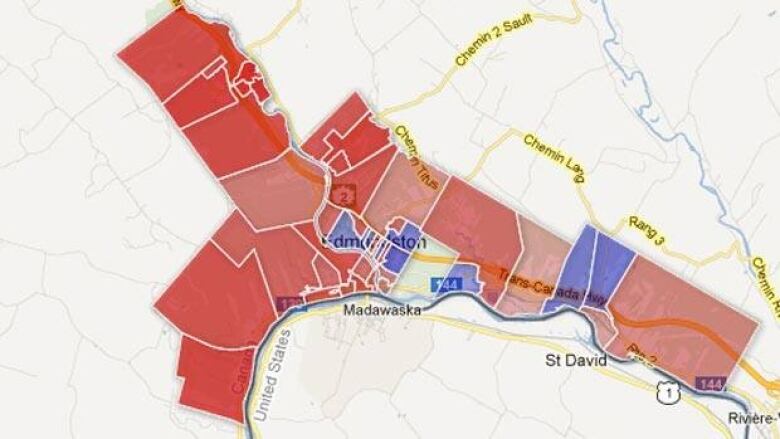Edmundston voting map shows old divisions remain
Jacques Martin won polls in St. Basile area of Edmundston

Fourteen years after Edmundston amalgamated with several nearby communities, those strong local connections are continuing to show up in voting patterns.
Edmundston voters offered political newcomer, Cyrille Simard, a substantial margin of victory on May 14.
Simard won the support of 60.8 per cent of the electorate, but several voting patterns quickly emerged in a poll-by-poll analysis of the election.
Simards vote was heavily concentrated in the St. Jacques area of the northwestern city.
Meanwhile, Jacques Martin, who was the incumbent mayor, saw his support consolidated mainly in the St. Basile area, where he was once a mayor prior to the amalgamation.
"Obviously, the polls where the population is younger, I would say in the St. Jacques area, [support]is very strong. Edmundston north also has young families, those voted for me," Simard said.
"I checked every poll where I lost and I could identify in all those instances, those in the middle of the city, what we call Edmundston Est, these are polls where the population is older. And those in the section of St. Basile, Jacques Martin, was mayor before the fusion. He had a good base there."
Simards largest margins of victory were all in the St. Jacques area or in areas west of the downtown core. He won several polls, some with more than 80 per cent of the vote, in the area.
By comparison, Martin won his polls in two specific areas. Martin won some polls in the old St. Basile area with about 60 per cent of the vote. In the St. Basile-area polls where Simard won, his margins were close to 50 per cent.

Martin also won a handful of polls near the Edmundston Regional Hospital and the New Brunswick Community College. While Martin did not sweep that section of the city, he held Simard to some smaller margins of victory.
Simard won three polls in the Edmundston Est area, but his margins were 51 per cent, 53 per cent and 61 per cent.
The electoral map paints a clear picture for Simard as he starts his political career.
The mayor said the voter support map shows he needs to make sure he visits the areas that were solidly behind Martin. He said he also realizes there could be a generational divide showing up in the voter support figures.
The areas of the city that tend to have higher concentrations of older residents tilted toward Martin.
"Obviously, I knew that I was less known with the older citizens in Edmundston, that is a fact. Even though Im 50 years old, I could reach out more to people 50 and under," he said.
Merger fallout
Edmundston, St. Basile, St. Jacques and Verret merged to form the amalgamated city of Edmundston in 1998.
Simard said the ability to pick out factions across the city in the voting map shows politicians need to work hard to smooth any lingering tensions from the 1998 merger.
If an average Edmundston resident looked at the voter support map, Simard said, they would see the need to address any questions that may remain about the municipal merger.
"They would see that within the city we still have some work to do build the Grand Edmundston. They see St. Jacques is strong for me and St. Basile less and in Edmundston centre," he said.
Edmundston saw its population drop 3.7 per cent to 16,032 residents, according to the 2011 census.
The census data also shows Simard's strength among younger voters in Edmundston may not be helpful in future elections.
The percentage of people 65 years or older in Edmundston is 18.5 per cent, which is far above the national average of 14.8 per cent or the New Brunswick average of 16.5 per cent.












_(720p).jpg)


 OFFICIAL HD MUSIC VIDEO.jpg)
.jpg)



























































































